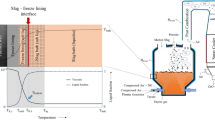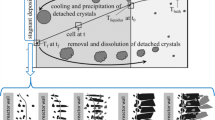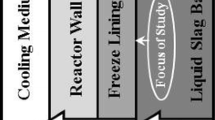Abstract
Freeze-lining technologies have been employed to protect the cooling walls of reactors from chemically aggressive molten reactants. To date, the designs of freeze linings for pyrometallurgical reactors have been based on the basic assumption that the interface between the deposit and the bath remains at the liquidus temperature of the bulk liquid. There is, however, increasing evidence that interface temperature between stagnant deposit and bath is less than the liquidus of the bulk liquid. A previous study also demonstrated that the effects of bath chemistry need to be taken into account in freeze-lining designs. To investigate the fundamental processes involved in the formation and stability of the deposit, experimental laboratory studies have been undertaken in the Cu-Fe-Si-Al-O slag system in equilibrium with metallic copper using an air-cooled probe technique. In the current study, the effects of bath agitation on the microstructure, morphologies of the phases, and formation of various layers across the freeze-lining deposit were studied at steady-state conditions. It appears that the changes in the fluid flow pattern through changes in shear intensities result in corresponding changes in the deposit microstructure, formation of the sealing primary phase layer, thus influencing the interface temperature between freeze-lining deposit and the liquid bath.













Similar content being viewed by others
References
A. Fallah-Mehrjardi, P.C. Hayes, and E. Jak: Metall. Mater. Trans. B., 2013, vol. 44B, pp. 534–48.
A. Fallah-Mehrjardi, P.C. Hayes, and E. Jak: Metall. Mater. Trans.B., 2013, vol. 44B, pp. 549–60.
M. Campforts, B. Blanpain, and P. Wollants: Metall. Mater. Trans. B., 2009, vol. 40B, pp. 643–55.
M. Campforts, E. Jak, B. Blanpain, and P. Wollants: Metall. Mater. Trans. B., 2009, vol. 40B, pp. 619–31.
K. Verscheure: PhD Thesis, Katholieke Universiteit Leuven, 2007.
K. Verscheure, M. Van Camp, B. Blanpain, P. Wollants, P. Hayes, and E. Jak: Metall. Mater. Trans. B., 2007, vol. 38B, pp. 21–33.
K. Verscheure, A.K. Kyllo, A. Filzwieser, B. Blanpain, and P. Wollants: Furnace Cooling Technology in Pyrometallurgical Processes, TMS, Warrendale, PA, 2006, pp. 139–54.
K. Verscheure, F. Verhaeghe, E. Boydens, M. Van Camp, B. Blanpain, and P. Wollants: Metall. Mater. Trans. B., 2006, vol. 37B, pp. 929–40.
M. Campforts, E. Jak, B. Blanpain, and P. Wollants: Metall. Mater. Trans. B., 2009, vol. 40B, pp. 632–42.
M. Campforts, K. Verscheure, T. Van Rompaey, E. Boydens, B. Blanpain, and P. Wollants: Metall. Mater. Trans. B., 2007, vol. 38B, pp. 841–51.
A.K. Kyllo and N.B. Gray: Composite Furnace Module Cooling Systems in the Electric Slag Cleaning Furnace, EMC, Dresden, Germany, 2005, pp. 1027–34.
P.C. Pistorius: JSAIMM, 2003, vol. 103(8), pp. 509–14.
P.C. Pistorius: JSAIMM, 2004, vol. 104(7), pp. 417–22.
J.H. Zietsman and C. Pistorius: Miner. Eng., 2005, vol. 19(3), pp. 262–79.
D.G.C. Robertson and S. Kang: Proceedings of International Conference on Fluid Flow Phenomena in Minerals Processing, Warrendale, PA, TMS, 1999, pp. 157–68.
K. Verscheure, M. Van Camp, B. Blanpain, P. Wollants, P. Hayes, and E. Jak: Metall. Mater. Trans. B., 2007, vol. 38B, pp. 13–20.
H. Joubert: International Conference on Molten Slags and Fluxes, Stockholm, Helsinki, 2000.
M. Campforts, K. Verscheure, E. Boydens, T. Van Rompaey, B. Blanpain, and P. Wollants: Metall. Mater. Trans. B., 2008, vol. 39B, pp. 408–17.
P. Taskinen, M. Kaskiala, P. Hietanen, K. Miettinen, and A. Forsström: Trans. Inst. Min. Metall. C, 2011, vol. 120, pp. 147–55.
F. Guevara and G. Irons: Metall. Mater. Trans. B., 2011, vol. 42B, pp. 652–63.
F. Guevara and G. Irons: Metall. Mater. Trans. B., 2011, vol. 42B, pp. 664–76.
FactSage ver. 6.2., CRCT-Thermfact Inc. & GTT-Technologies, 2010, Montreal, Canada.
T. Hidayat and E. Jak: CALPHAD XLI, Private Communication, Berkeley, CA, 2012.
T. Hidayat, H.M. Henao, P.C. Hayes, and E. Jak: Metall. Mater. Trans. B., 2012, vol. 43(5), pp. 1034–45.
A. Fallah-Mehrjardi, P.C. Hayes, and E. Jak: Unpublished research, 2013.
A. Das, S. Ji, and Z. Fan: Acta Materialia, 2002, vol. 50, pp. 4571–85.
M.C. Flemings, Solidification Processing. McGraw-Hill, New York, NY, 1974.
W. Kurz and D.J. Fisher: Fundamentals of Solidification, 3rd ed., Trans Tech Publications, Aedermannsdorf, 1989.
S. Nafisi and R. Ghomashchi: Mater. Sci. Eng. A, 2006, vol. 437, pp. 388–95.
Z. Fan, G. Liu, and M. Hitchcock: Mater. Sci. Eng. A, 2005, vols. 413–414, pp. 229–35.
F.P. Incropera and D.P. DeWitt: Fundamentals of Heat and Mass Transfer, 5th ed., Wiley, Hoboken, NJ, 2002.
Acknowledgments
The authors would like to thank the Australian Research Council Linkage program, Rio Tinto Kennecott Utah Copper, Corp., Xstrata Technology, Xstrata Copper, BHP Billiton Olympic Dam Operation, and Outotec Finland Oy for their financial supports.
Author information
Authors and Affiliations
Corresponding author
Additional information
Manuscript submitted April 28, 2013.
Appendices
Appendices
Appendix A: Temperature Profile across the Deposit
The temperature distributions across the deposit was determined by means of the measured values obtained from thin thermocouples (see Figure 4(a), an example for 0-RPM experiments) at steady-state conditions using 1D cylindrical coordinates as a logarithmic function of system radius.[31]
where T (°C) and r (m) are temperature and radius of the system. A and B in Eq. [A1] are constants, determined by interpolation of measured values. Note that radius of each point is the sum of radius of the cold probe and the distance from the cold finger.
Appendix B
Detailed measurements of the temperatures across the deposit thickness enabled estimation of thermal parameters, such as the effective thermal conductivity of the freeze lining for the given bulk bath composition and the convective heat-transfer coefficients at the bath/deposit interface at steady-state conditions. The 1D heat-transfer model of the freeze lining in cylindrical coordinates used in this analysis takes into account the coolant, the deposit thickness and bath rotation. The heat-transfer equation[31] was solved for steady-state conditions. The heat extracted through the cold-finger probe, Q, is determined through measurement of the difference between gas coolant inlet and outlet temperatures using Eq. [B1]:
where Q, \( m < \dot{m}, \) C p, air, T outlet, air and T inlet, air are the total heat flow (W), air flow rate (kg s−1), heat capacity of air (J kg−1 K−1), air outlet temperature (B-2) and air inlet temperature (A-1), respectively, at steady-state conditions. The heat output through the cold probe was found to be 472 J s−1 at steady-state conditions for bath temperature: 1438 K (1165 °C), air flow rate: 100 L min−1, and various bath agitations (0-, 20-, and 60-RPM) at steady-state conditions.
Equation [B2] was developed by using Fourier’s law in the cylindrical coordinate system at steady-state conditions to relate total heat flow, Q, and temperature difference across the deposit.
where the terms L, k fl, T, and r are the immersion depth of the probe (m), the thermal conductivity of freeze lining (W K−1 m−1), the temperatures (K), and radius (m) of cold-probe surface (r 1) and the radius of stagnant interface between the deposit and bath (r 2).
Since Q can be calculated using Eq. [B1], and if it is assumed that the thermal conductivity of the freeze lining is constant regardless of temperature and composition variation, then the only unknown is the mean heat conductivity of the freeze lining, k fl; for the conditions investigated.
At steady-state conditions the total heat flow (W) through the deposit can also be described by Eq. [B3]
where A bf, h bath, T bath, and T f are the area normal to the direction of heat transfer (m2), the convective heat-transfer coefficients of the bath (W K−1 m−2), bath temperature (K), and the interface temperature, respectively (the latter is assumed to be the liquidus temperature of the bulk bath). The apparent bath convection heat-transfer coefficient was estimated using Eqs. [B1] and [B3].
Rights and permissions
About this article
Cite this article
Fallah-Mehrjardi, A., Hayes, P.C. & Jak, E. Investigation of Freeze Lining in Copper-Containing Slag Systems: Part III. High-Temperature Experimental Investigation of the Effect of Bath Agitation. Metall Mater Trans B 44, 1337–1351 (2013). https://doi.org/10.1007/s11663-013-9925-6
Published:
Issue Date:
DOI: https://doi.org/10.1007/s11663-013-9925-6




